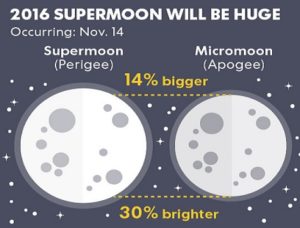According to the American Space Agency NASA, November 14, 2016, moon will be the biggest and brightest it has been in the 68 years.This moon will be a rare ‘supermoon’ making an appearance early morning just before dawn. It will appear especially bright because it is the closest it has been to Earth since Jan. 26, 1948 which won’t be seen until Nov. 25, 2034.
- November’s full moon has been given a special name: Beaver Moon. November’s moon type is commonly called a “supermoon”, or technically a “perigee full moon”

- Perigee is a phenomenon that occurs when a full moon coincides with the moon being the closest it gets to the Earth on its orbit.
- On November 14 at 6:15 a.m. EST, the moon will arrive at its closest point to the Earth in 2016 at distance of 221,524 miles (356,508 kilometers) away.
- This distance, which is measured from the center of the Earth to the center of the moon, is within 85 miles (137 km) of the moon’s closest possible approach to Earth.
- Two hours and 37 minutes after perigee (the moon’s closest point to Earth), the orbit will officially turn full.
Supermoon :
Supermooons are about 30% larger in area and 30% brighter than the smallest full moons.
- Smallest full moons happen when the moon is at its furthest distance from Earth; that is at the “apogee”.
- In terms of diameter – the width of the moon – it will be about 14% wider than the smallest full moons.
- One of the easiest way to catch a glimpse of the supermoon is via the Slooh Community Observatory which is offering a live broadcast starting November 13 at 8 p.m. ET.
- According to the scientist there will be another supermoon next month.
What causes supermoon ?
The moon’s orbit around the Earth is slightly elliptical, so sometimes its closer and sometimes it’s farther away.
- When the moon is full as it passes closest to the Earth, it’s called a “supermoon.”
- At that point, it can be as much as 14 percent closer to the Earth than at apogee, or when it’s furthest away.
- The proximity makes the full moon appear much larger in diameter and because it is larger, it shines 30 percent more moonlight onto the Earth.
- The increase in actual size of the moon’s image from a normal supermoon is totally swamped by phenomenon known as the “moon illusion”, which affects one’s perception of the size of the moon.
- When the moon is close to the horizon, it can appear up to 300% the size it does when it is high in the sky – which makes much more of a difference than the actual 7% boost you get from it being a bit closer to the Earth.
- That moon illusion (as the name suggests) is a complete illusion – the image of the moon does not change significantly at all as it moves from the horizon up into the sky. But, when it is close to the horizon, observers think it looks bigger.
AffairsCloud Recommends Oliveboard Mock Test
AffairsCloud Ebook - Support Us to Grow
Govt Jobs by Category
Bank Jobs Notification





